Stretching has been part of sports for a long time. First, it was a mainstay before any exercise activity and was usually referred to as “calisthenics,” involving activities like jumping jacks, push-ups, knee bends, or sit-ups, to name a few. Then a new trend developed, “stretching after activity.” This actually made sense to give the athlete the opportunity to stretch the tightened muscles and joints after activity to increase ranges of motion and reduce soreness.
With the advances of technology and research, numerous studies have been conducted on the pros and cons of stretching in injury reduction and performance enhancing. Many of these studies have found that there is no actual benefit in stretching prior to activities and, in some cases, it actually inhibits performance when an athlete overstretches a muscle or muscle group.
However, some factors need to be considered when we look at these studies. Most were performed on athletes who were already conditioned, like experienced runners, for example. A typical runner would perform a short stretch of the lower leg muscles and begin the run—starting at a slower pace to stimulate circulation, loosen joints and muscles. Then, gradually increasing the pace to his or her training level, the runner would finally end the work out with a cool down period and more thorough stretching designed to loosen tight muscles and joints. As we look at the above scenario, it seems the purpose is not to stretch muscles, but the joints. From a physiology standpoint, if we were to tear muscle tissue, we know the end result would be swelling, tissue discoloration and possible palpable mass (hematoma). The ultimate tightness that may or may not develop within the muscle comes from the repetitive concentric and eccentric contraction of the muscle.
Perhaps the real answer to reducing injury is through the generalized easy jog or “warm-up” to loosen up the structural joints: ankle, knee, hip, spine, shoulder, elbow and wrist. Consider the anatomy of these joints; most are enclosed by a capsular ligament which—like any other ligamentous tissue—when overstretched from a specific trauma or repetitive trauma, results in a pain syndrome.
Anatomy-wise, we know muscle tissue—due to its high blood and nerve supply—heals quicker than tendonous and ligamentous tissue. The secret to stretching could be stimulating a slight stretch on the capsules, not major muscle groups. A good example of this is the patient who enters our office with a “frozen shoulder.” When we muscle test the patient’s rotator cuff muscles, it may produce pain on specific movements, but we feel resistance and a positive end point. Usually these are negative on MRI of any tearing of muscle tissue, so what is creating his pain and restricted ranges of motion?

Through our consultation, we might identify a precursory movement, like reaching high into a cabinet for something or reaching up to hang a picture on a wall. If the involved joint had not been loosened or been placed in sequences leading up to the movement, it did not take the muscle past its range of motion but actually stressed the capsular ligament.
The majority of our practices are not made up of the conditioned athlete, but of the factory worker, office personnel, and farmer. These patients do repetitive activities; when they overexert a joint, it results in a pain cycle causing them to call their friendly chiropractor.
So, do we instruct our patients to perform certain stretches to avoid injury? The answer varies from patient to patient. If the patient participates in an activity that requires maximum flexibility, like diving, swimming, or gymnastics, we must ensure that they have full ranges of motion in all joints.1 If our patient is an athlete, we may want to recommend certain stretches based on previous injury or measurable restrictions in a specific range of motion, with an emphasis on proper warm-up and stretching afterwards. For our non-athletic patients, we should tailor stretches to their activities of daily living.
A primary consideration for all our patients, in preventing injuries and reaggravation, is to maintain a healthy level of cardiovascular conditioning. Simple activities, such as walking, go a long way in developing a good level of fitness. As Stuart McGill points out, “Only biomechanical overload can cause tissue damage.”2
Some practical tips for helping patients avoid injury:
• If stretches are recommended, have the patient warm-up muscles and joints with a light aerobic activity (walking, jogging, etc.)
• Stretches should be done slowly, holding the stretch for fifteen to thirty seconds and repeated up to two to three times per muscle group
• Tailor stretches to be job or sport specific
• Above all else, make sure the stretch is being performed in a proper movement pattern to not compromise other tissues and joints
A 1980 graduate of Palmer College of Chiropractic, Dr. Kirk Lee is a member of the Palmer College of Chiropractic Post Graduate Faculty and Parker College of Chiropractic Post Graduate Faculty. He has lectured nationwide on sports injuries and the adolescent athlete, and currently practices in Albion, Michigan.
References
1. Gatorade Sports Science Institute, Sports Science Exchange. Should you Stretch before exercise? Vol. 20, Number 1. 2007.
2. McGill, S, PhD. Ultimate Back Fitness and Performance. Wabuno Publishers. 2004.
3. Alter, M. Understanding Flexibility. Sport Stretch. Human Kinetics. 2000.
4. Anderson, B. Stretching. Shelter Publications. 2000.
